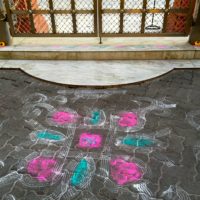Blessings
I’ve read that violence is decreasing in the world. It’s hard to believe this as we are bombarded with acts of violence nearly every day. Everyone is a potential journalist; we all have instant access to recording devices. And viewing devices. It’s hard not to know about the latest violence. Unless you hide under a rock. It’s tempting.
Young black men killed by cops. Cops killed by snipers. Trucks driving through crowds of random people. Men and women willing to kill themselves in suicide vests. Drones taking out whole villages. It goes on until we weep. Until we cannot weep.
What to do in the face of it? The numbers don’t really mean much to me. The why I can sort of understand. Fear and anger seem to be flooding the world. When we get to the limit of powerlessness or the height of ego human beings go over the edge of decency. Of humanity. I do get the anger and the fear.
But I am searching. Many are searching. What can we do? How do we somehow put one tiny fingerprint of hope on this desolate landscape?
Pause. Think before you act. Think before saying the first thought that pops into your head. So often anger sends forth a bad word or a rude gesture. Driving can bring out the worst. I’m making an effort to consider that the person who cut me off is just in a bigger hurry than I am. Breathe. Don’t react. Offer a blessing for the person who angers you.
Read. Educate yourself. This list of books seems like a good way to learn about the experience of being Black in America.
Absorb culture. After watching “The Free State of Jones,” I wonder how anyone can deny the need for reparation to those who were brought here as slaves. And those whose land the Europeans stole.
See? It’s pretty hard to even write about this without sounding lame. Fake. Patronizing. When I say “you” I mean we. I mean us. I mean me. I mean I. I read something like this and think that the burden is unfairly placed on the shoulders of the Black boy, the Black man, the Black woman. It’s time for all of us to pick up our share of the load.
















